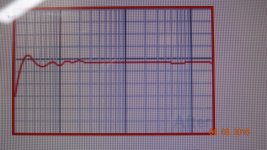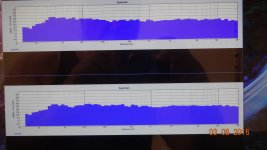The Mc 5808 looks great, and John Atkinson calls its performance 'excellent', so that deserves a compliment. But frankly, certainly the power amp, shows rather middle of the road performance distortion wise. A TPA3255 with good output coils does better. The designers of this amp are surely aware of this. So my question is: are there some trade offs made here between distortion and some other desired quality, and if so, what are these qualities?
The Mc 5808 looks great, and John Atkinson calls its performance 'excellent', so that deserves a compliment. But frankly, certainly the power amp, shows rather middle of the road performance distortion wise. A TPA3255 with good output coils does better. The designers of this amp are surely aware of this. So my question is: are there some trade offs made here between distortion and some other desired quality, and if so, what are these qualities?
This amp is praised by many for its wonderful sound reproduction in all different stages and is as complete as an integrated amplifier can be.
Simply a wonderful looking gem from a very reputable brand.
Congratulations to Dimitri for being the happy owner.
Merry Xmas to all,
Hans
... Happy designer...Congratulations to Dimitri for being the happy owner.
- Because it is an industrial product, the announced performances have to be worse than the worst sample out of the factory ?But frankly, certainly the power amp, shows rather middle of the road performance distortion wise. A TPA3255 with good output coils does better. The designers of this amp are surely aware of this. So my question is: are there some trade offs made here between distortion and some other desired quality, and if so, what are these qualities?
- It is not a class D amp. It must be believed that I am not the only one to find that class D amps have a special character ?
Last edited:
We should not obsess over distortion.
I think low noise (as in hum etc) is a more worthy goal.
In any event, congratulations Dimitri!
I think low noise (as in hum etc) is a more worthy goal.
In any event, congratulations Dimitri!
How about sharing the charts like you have been? Say, a few images with the most important one first and then next ones in order.
I'll show you test results not seen often; Headphone auto EQ'ed via DSP.
View attachment Dr Dre Headphone EQ with Audyssey -1.pdf
For those who would like to know how the measurement was done, it is in Linear Audio headphone amp article..... Using a real dummy head.... mine 🙂
More accurate than a generic ears' shape and texture and volume ... you use your own ear's shape and volume etal. Now all headphone can have accurate freq response.
Since this method was demonstrated, several commercial spin-off's of the concept are in development with some new spin added to the process.
My gift.
Yes, it is another slap to the forhead... why didnt someone think of this before and try it?
THx-RNMarsh
Last edited:
mc head preamp - Quad MC with ZTX devices, but balanced in/balanced out
mm preamp - conventional balanced in/balanced out mike preamp with JFET input devices
preamp/headphone amp - fully differential (balanced in/balanced out) like OPA1632 with MAS6116 R-2R volume controls, input stage similar to LM6172
power amp - balanced input, input stage similar to LM6172
LM6172. Nice. Very fast. CFB with buffered IN's into act as fast VFA. Nice. Same idea Damir used on his PA.
Should be really good.
🙂 😎
THx-RNMarsh
Evenharmonics -
.... and here is a corrected or EQ'ed response for an other headphone.

Speakers are a serious problem for those who do not like to have a lot of room interference patterns in their sound. peaks and nulls. Reflections. So, can you get flat or reasonably flat and thus more accurate frequency response with widely spaced and far back in a room> usually not. Especially, below 500Hz you get wild variations. With a few exceptions you need to have control of the dispersion. The wide dispersion is a disaster for far field room listening.
Here is how controlling dispersion and care to prevent early reflections and attenuate them can produce a pretty good freq response and excellent imaging with speakers 12 feet apart and 15 feet into the room as the listening position; with no EQ applied:

JBL M2
However, the best solution is to listen to the speakers near-field and with headphones; both, can be used to compare.
THx-RNMarsh
.... and here is a corrected or EQ'ed response for an other headphone.

Speakers are a serious problem for those who do not like to have a lot of room interference patterns in their sound. peaks and nulls. Reflections. So, can you get flat or reasonably flat and thus more accurate frequency response with widely spaced and far back in a room> usually not. Especially, below 500Hz you get wild variations. With a few exceptions you need to have control of the dispersion. The wide dispersion is a disaster for far field room listening.
Here is how controlling dispersion and care to prevent early reflections and attenuate them can produce a pretty good freq response and excellent imaging with speakers 12 feet apart and 15 feet into the room as the listening position; with no EQ applied:

JBL M2
However, the best solution is to listen to the speakers near-field and with headphones; both, can be used to compare.
THx-RNMarsh
Last edited:
"We all share", is what I said (what do your quote marks mean?) you as well, believe it or not
First you use "we" to define a group to which I (you know the "HE" aka Jakob) do not belong and then you use "we" to denote the group that includes me.
Sure that the switch must have been obvious to me? Ok, the "all" could have been my guide, but ....
What the scare quotes mean? It expressed my surprise that I should know what "we all" / "you all" know/share about psychoacoustics.
As I've said before, communication is based on a mutual understanding of the meaning of words and if I ask for clarification then the reason is, that I assume not having got what somebody was asking/writing. Snitty remarks about " he diverts" do not help.
And if you use terms with a certain meaning in the field in a different way than usual it adds to the confusion.
The term "psychoacoustic" denotes the field where the research takes place about the way (and if at all) humans response to acoustical input; you know, as I've said quite often in the past, Blauert for example defines psychoacoustics as the way to find out if an acoustical event leads to an auditory event (means not only a basic physiological reaction in the hearing apparatus but all the way up).
No, I don't refuse to clarify. There are elements of psychoacoustics that we all share, those which have evolved as an aid to survival as T mentioned, and those which apply to individuals' experiences etc. I'm asking to which you refer. I hope that is clear and you are able to answer.
Is the above trolling another attempt to divert?Sorry, but of course you did. Otherwise you've written the paragraph above right at he beginning and I would have noticed your quite special usage of the term "psychoacoustics" at an early stage. So again, we have wasted time.
Again sorry, but afair I've answered your numerous questions whenever possible (pointed to the evidence, cited the publications and offerend my conclusions) and what did I get in return?
Weren't you engaged in "FUD shouting", didn't you invent the "scare quotes" and weren't you just now again accusing me of "diverting" ? Not to mention your whining about the length of my posts and some repetitions? 😉
So, if listing the facts is "trolling" in your book ....
And again, if you don't like your mirror image, the remedy is obvious; mind the mirror or act differently in front of it.
Overall, I still don't know what you're "driving at" and still don't know which part of my posts the "referral" should/could have been.......
Last edited:
Does the term multidimensional relate to psychoacoustics in this context?The term "psychoacoustic" denotes the field where the research takes place about the way (and if at all) humans response to acoustical input
It's the intention eg "posting inflammatory, extraneous, or off-topic messages in an online community with the intent of provoking other users into an emotional response or of otherwise disrupting normal on-topic discussion."So, if listing the facts is "trolling" in your book ....
I'm driving at a differentiation between the elements of psychoacoustics we all share and those we don't, ie those which relate to personal experience. I hope that helps.Overall, I still don't know what you're "driving at" and still don't know which part of my posts the "referral" should/could have been.......
I measure everything.. not just amps.
What about the measurements of the room acoustics where you've done your listening evaluations to find out which amp is good sounding?
yes. what would you like to know from me about that specifically? What room acoustic measurements are of interest to you?
How about sharing the charts like you have been? Say, a few images with the most important one first and then next ones in order.
Measurements of the room acoustics = headphone measurement? I don't understand your way of replying.I'll show you test results not seen often; Headphone auto EQ'ed via DSP.
View attachment 804544
For those who would like to know how the measurement was done, it is in Linear Audio headphone amp article..... Using a real dummy head.... mine 🙂
More accurate than a generic ears' shape and texture and volume ... you use your own ear's shape and volume etal. Now all headphone can have accurate freq response.
Since this method was demonstrated, several commercial spin-off's of the concept are in development with some new spin added to the process.

That's the real bottleneck of audio reproduction, not amps and DACs.Speakers are a serious problem for those who do not like to have a lot of room interference patterns in their sound. peaks and nulls. Reflections.
Finally. Thanks for sharing. Is that where you and Markw4 auditioned DACs a few months ago?Here is how controlling dispersion and care to prevent early reflections and attenuate them can produce a pretty good freq response and excellent imaging with speakers 12 feet apart and 15 feet into the room as the listening position; with no EQ applied:
We should not obsess over distortion.
I think low noise (as in hum etc) is a more worthy goal.
In any event, congratulations Dimitri!
I agree that it is usually a bigger problem to drive noise down than distortion. I also agree that distortion figures aren't that important provided they are below a certain threshold.
My question relates to the following. It is not that hard to mount an amp that distorts an order of magnitude less than the 5808. So, I figure that it must be a design decision to have distortion at the level it is, technically it can be better, so is there a tradeoff being made here with other qualities? If so, what are those other qualities?
Measurements of the room acoustics = headphone measurement? I don't understand your way of replying.
That's the real bottleneck of audio reproduction, not amps and DACs.
Finally. Thanks for sharing. Is that where you and Markw4 auditioned DACs a few months ago?
yes, just closer distance listening (near-field).
-RNM
Last edited:
Where do-you found those measurements ?It is not that hard to mount an amp that distorts an order of magnitude less than the 5808.
Or may-be you confused with specifications ?
Looks like the low octave needs work, bass traps, location rearrangement or subwoofer augmentation.yes, just closer distance listening (near-field).
Any other measurements of the room?
That was my first question: Where ?Stereophile did some measurements, my dear prof. T.
[edit]: Ok, found-it.
Last edited:
Mark Levinson No.5805 integrated amplifier Measurements | Stereophile.com
Seriously going to the website and having a look is too hard for you?
Seriously going to the website and having a look is too hard for you?
- Status
- Not open for further replies.
- Home
- Member Areas
- The Lounge
- John Curl's Blowtorch preamplifier part III
